Source - http://heritageofjapan.wordpress.com/
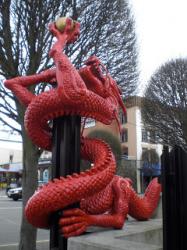
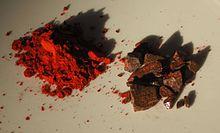
The symbolism of cinnabar or dragon’s blood according to The Symbolism of cinnabar or ‘Dragons’ blood:
“Cinnabar was recognized as a mystical powder because it is produced from volcanic and/or hot springs activity. The heat that results in the creation of cinnabar comes from the very heart (centre) of the earth. Its red colour depicts both the heart (blood) and burning embers of a fire. As a result, it has the ability to both foster positivity and cause destruction. The ‘magic’ of cinnabar is that it opens doors of opportunity for the future while putting negative experiences of the past to rest.”
According to the website, minerals-n-more.com, the word ‘cinnabar’ comes from the Persian word for ‘dragon’s blood’ and cinnabar has been mined since the days of the Roman Empire and it is still ‘harvested’ and used for both practical and metaphysical purposes.
Cinnabar production in Japan
The village of Niu (literally meaning “cinnabar producing”) was the producing place of red stones, red soil and vermillion (mercury). It is said that the tribes that had the skills in mining and moved from place to place seeking for mineral resources gave the name to this place.
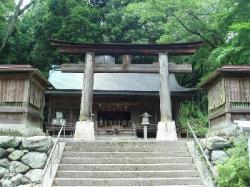
Niu Kawakami Shrine Shimo-sha
Niu Kawakami Shrine Shimo-sha located in Shimoichi-cho, Yoshino-gun, Nara Prefecture is one of the three Niu Kawakami shrines that have existed since the ancient times. The three shrines are respectively called Kami-sha (the top shrine), Naka-sha (the middle shrine) and Shimo-sha (the bottom shrine). The Shimo shrine enshrines Kura Okami no Kami (the god of water and rain). According to the shrine record, it was founded in 676, when the god said,
“If you set up the holy pillars of my shrine in this deep mountain, I will bring the blessed rain instead of the damaging rain for the people of this country.”.. The present Shimo shrine is thought to have been the ancient Kami shrine. (Source: Nippon-kichi 丹生川上神社下社 Niu-kawakami-jinjya-shimo-sya Niu Kawakami Shrine Shimo-sha)
However, cinnabar use in Japan goes back much earlier to Initial and Early Jomon times, becoming common in Late Jomon times, according to Nelly Nauman’s “Japanese Prehistory: The Material and Spiritual Culture of the Jōmon Period“. Red oxide uses were earlier known widely used in burial rituals but as early as Early Jomon, was also used for lacquering wooden and clay vessels. Red was also a popular colour not just in tomb burial usage, but also for colouring craft and fashion items (see The color red and Jomon people).
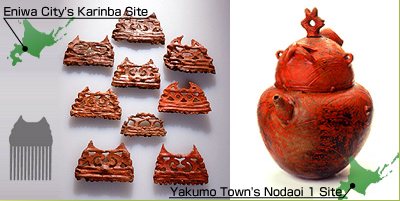
But the earliest cinnabar ores and production implements were found from the Ojibar site of the Late Jomon period and painted objects from the Shimoda site in Gunma prefecture. Cinnabar production of items for trade was seen from sites south of Ise, like Morizoe and Tenpaku.
Tracing the industry of cinnabar production:
The earliest use of the cinnabar mineral is from the Neolithic site of Çatalhöyük in Turkey (7000-8000 BC) where wall paintings included cinnabar’s vermillion. “The primary prehistoric use of the mineral was grinding it to create vermillion”, according to Cinnabar: History of Mercury Mineral Use. The article also puts the use of cinnabar as a pigment beginnning ~5300 BC. Lead isotope analysis identified the provenance of these cinnabar pigments as coming from the Almaden district deposits[Iberian peninsula]. (see Consuegra et al. 2011).
Also important locations, according to the above article, on the early cinnabar trail are:
“The Neolithic Vinca culture (4800-3500 BC), located in the Balkans and including the Serbian sites of Plocnik, Belo Brdo, and Bubanj, among others, were early users of cinnabar, likely mined from the Suplja Stena mine on Mount Avala, 20 kilometers (12.5 miles) from Vinca. Cinnabar occurs in this mine in quartz veins; Neolithic quarrying activities are attested here by the presence of stone tools and ceramic vessels near ancient mine shafts.
In China, the earliest known use of cinnabar is the Yangshao culture (~4000-3500 BC). At several sites, cinnabar covered the walls and floors in buildings used for ritual ceremonies. Cinnabar was among a range of minerals used used to paint Yangshao ceramics, and, at Taosi village, cinnabar was sprinkled into elite burials.”
In both Mesoamerica and South America, cinnabar was an important trade item. The Mayan may have considered cinnabar to be sacred because of its red color. Red was considered to be the color of the east, and may also have symbolized blood as well as life, though there is no solid evidence for this.The ancient Maya used cinnabar in their jewelry, set into incised decorations, as a paint pigment and as part of certain rituals such as funeral rituals and rituals involving fire. For rituals involving fire, Mayan priests would burn cinnabar to release the mercury.
Since Olmec culture is thought to be derived from the Chinese migrantsof the Shang dynasty, it is possible that cinnabar use and mining technology came from the China. In 1975, Betty Meggers of the Smithsonian Institution argued that the Olmec civilization originated due to Shang Chinese influences around 1200 BC. Olmec culture shares both cinnabar and jade production techniques.
Cinnabar: Its brutal history and transformation Catherine’s Blog About Jewelry, Gemstones, wrote:
“Theophrastus (372 BC- 288 BC), a Greek naturalist, mentions the use of cinnabar as early as the 6th century BC. But early Chinese objects show traces as far back as the second millenium BC. The Romans mined cinnabar ores for mercury near the Gulf of Trieste and in Almaden, Spain (home of the largest mercury mine in the world). Several of these mercury mines are still in use today, 2500 years later. According to Rome’s famous engineer, Marcus Vitruvius Pollio (90-20 BC), miners of cinnabar ore quickly showed poisonous effects: tremors, extreme mood changes and loss of hearing progressing to severe mental derangement and death. The Romans solved the problem of toxicity by turning the cinnabar mines into penal institutions for criminals, slaves and other undesirables….
The Chinese realized the problems of mercury poisoning early on and, during the Sung Dynasty (960-1279), developed a technique that mimicked the carving of real cinnabar called “tsuishu”. The core of many pieces of jewelry was made of wood, then usually 100 to 300 layers of lacquer were applied. Each layers was allowed to dry for one day and then lightly polished. A motif was then carved into the piece. This was better than carving genuine cinnabar, but, unfortunately, to get the prized red color, the lacquer often had powdered mercuric sulfide added to it”.
Cinnabar is known to have been used for at least 2,000 years as part of Chinese and Indian Ayurvedic medicines and is still used in at least 46 traditional Chinese patent medicines today, making up between 11-13% of Zhu-Sha-An-Shen-Wan, a popular over-the-counter traditional medicine for insomnia, anxiety and depression.
At present, it is uncertain whether cinnabar production techniques in early Japan came from China and Western China sources, or the Caucasus-Siberian Altai Transbaikalian cultures.
“On Kamchatka Penin., at the Tamvatney deposit, cinnabar is represented in the composition of silification list-wanites; on the Chukchi Penin. – in the composition of quartzites and linariteof the Plamennoye deposit; and in Rep. of Tyva – in the composition of sandstones of the Terligkhaiskiy ore center. In the Ukraine, in Donetsk Region, quartzites with inclusions of cinnabar are known at the Nikitovka deposit, and at the Borkut deposit they described diorite porphyrites with cinnabar. In Kyrgyzstan, at the Chonksoy deposit, list-wanites are enriched with cinnabar. In Kazakhstan, at the Khaidarakan deposit, calcareous-quartz breccia is enriched with cinnabar, and at the Chagan Uzun deposit – limestone with cinnabar. In Tadzhikistan, similar rocks of the Dzhizhikrut deposit are brecciated limestones and barytocalcite with cinnabar. In the Priasovje territorz cinnabar has been extracted before A.D. According Herodot, red paint was received from it by Greeks. The Scythian name of the paint – “cannabis” – was close to its Greek name cinnabar – kinnabaris. It’s possible to assume that cinnabar is a word of the Scythian origin…. In China, cinnabar is added into varnishes as a coloring pigment for painting on caskets and other souvenirs.” — Source: Cinnabar (Russian Minerological Society)
However, we might infer a Chinese origin for cinnabar use since its use is closely associated with lacquering techniques, and the Kyoto National Museum attributes the Japanese lacquerware culture as of Chinese origins, see Chinese Carved Lacquerware:
“the lacquer tree grows not only in Japan, but in Southeast Asia, China, Korea and other parts of Asia. The lacquer tree does not, however, grow in Europe or America. In the West, lacquerware was often called “japan,” showing that lacquerware-making is an Asian art.
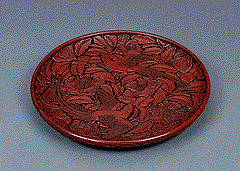
Carved Cinnabar Lacquer Tray with Blue Magpies and Camellias - China, Yuan Dynasty (14th century)
The history and culture of Japan, however, are not nearly as old as those of China! From the very beginnings, when Japan was still called the Yamato Taikoku and was ruled by the Empress Himiko, Japan has looked up to China and imported Chinese culture. This also relates to lacquerware; the Japanese actually learned the art of making lacquerware from China…”
Source readings:
The symbolism of Cinnabar or ‘Dragon’s Blood’
Cinnabar (Wikipedia)
Cinnabar: Its brutal history and transformation Catherine’s Blog About Jewelry, Gemstones
The Symbolism of cinnabar or ‘Dragons’ blood
Nelly Nauman “Japanese Prehistory: The Material and Spiritual Culture of the Jōmon Period“
Nippon-kichi 丹生川上神社下社 Niu-kawakami-jinjya-shimo-sya Niu Kawakami Shrine Shimo-sha)
Cinnabar (Russian Minerological Society)
Rutherford J. Gettens, Robert L. Feller and W. T. Chase, Vermilion and Cinnabar . Chase Studies in Conservation Vol. 17, No. 2 (May, 1972), pp. 45-69
minerals-n-more.com